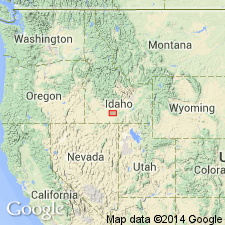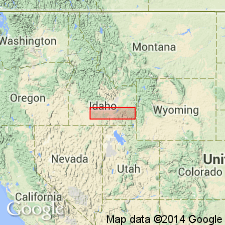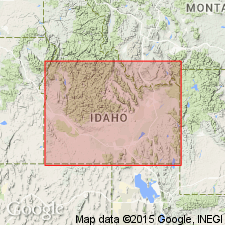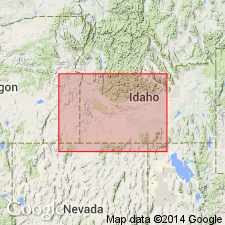
- Usage in publication:
-
- Hagerman lake beds*
- Modifications:
-
- Original reference
- Dominant lithology:
-
- Clay
- Silt
- Gravel
- Tuff
- Basalt
- Diatomite
- AAPG geologic province:
-
- Snake River basin
Summary:
Pg. 434-439; H.T. Stearns, 1932 (Correlation chart of Idaho compiled by M.G. Wilmarth, dated Sept 1, 1932). Hagerman lake beds. Nearly horizontal and partly consolidated buff to white clay and silt beds, which in most places contain a gravel cap 20 feet thick and occasional pebbly lenses and sandy beds near top. In places basic tuffs and flows are present, and one thin intercalated subaqueous basalt flow 200 feet below top is conspicuous for many miles along Snake River. Near mouth of Salmon Falls Creek the formation contains a 20-foot bed of diatomite. Thickness 600+/- feet. Underlies, unconformably, the undifferentiated series of early Pleistocene basalts, and is younger than Banbury volcanics. Vertebrate fossils in upper part are late Pliocene, according to Gidley.
Type locality: Hagerman Valley, Gooding and Twin Falls Cos., southern ID, where it forms prominent bluffs along Snake River.
Source: US geologic names lexicon (USGS Bull. 896, p. 895).

- Usage in publication:
-
- Hagerman lake beds*
- Modifications:
-
- Areal extent
- AAPG geologic province:
-
- Snake River basin
Summary:
Pg. 31, 52-56, pl. 4. Hagerman lake beds. Thickness about 600 feet. Overlie Banbury volcanics. Age is late Pliocene, based on fossils.
Source: US geologic names lexicon (USGS Bull. 1200, p. 1643-1644); supplemental information from GNU records (USGS DDS-6; Denver GNULEX).

- Usage in publication:
-
- Hagerman lake beds†
- Modifications:
-
- Abandoned
- AAPG geologic province:
-
- Snake River basin
Summary:
Pg. 17. †Hagerman lake beds. Term Hagerman lake beds is essentially synonymous with Idaho formation for area in which it has been applied but has the advantage that it is tied to upper Pliocene fossils whose stratigraphic relations are known definitely. These show that Hagerman lake beds appear to be continuous with Idaho formation of areas farther west, but detailed relationships remain to be determined.
Source: US geologic names lexicon (USGS Bull. 1200, p. 1643-1644).

- Usage in publication:
-
- Hagerman Lake Beds†
- Modifications:
-
- Abandoned
- AAPG geologic province:
-
- Snake River basin
Summary:
†Hagerman Lake Beds. Deposits reassigned to Glenns Ferry Formation (new) of Idaho Group. Abandoned because abrupt lithologic changes and poor exposures make beds unmappable beyond Hagerman, Gooding County, southwestern Idaho; deposits are a recognizable sedimentary facies duplicated in several other parts of Glenns Ferry.
Source: Modified from GNU records (USGS DDS-6; Denver GNULEX).
For more information, please contact Nancy Stamm, Geologic Names Committee Secretary.
Asterisk (*) indicates published by U.S. Geological Survey authors.
"No current usage" (†) implies that a name has been abandoned or has fallen into disuse. Former usage and, if known, replacement name given in parentheses ( ).
Slash (/) indicates name conflicts with nomenclatural guidelines (CSN, 1933; ACSN, 1961, 1970; NACSN, 1983, 2005, 2021). May be explained within brackets ([ ]).

